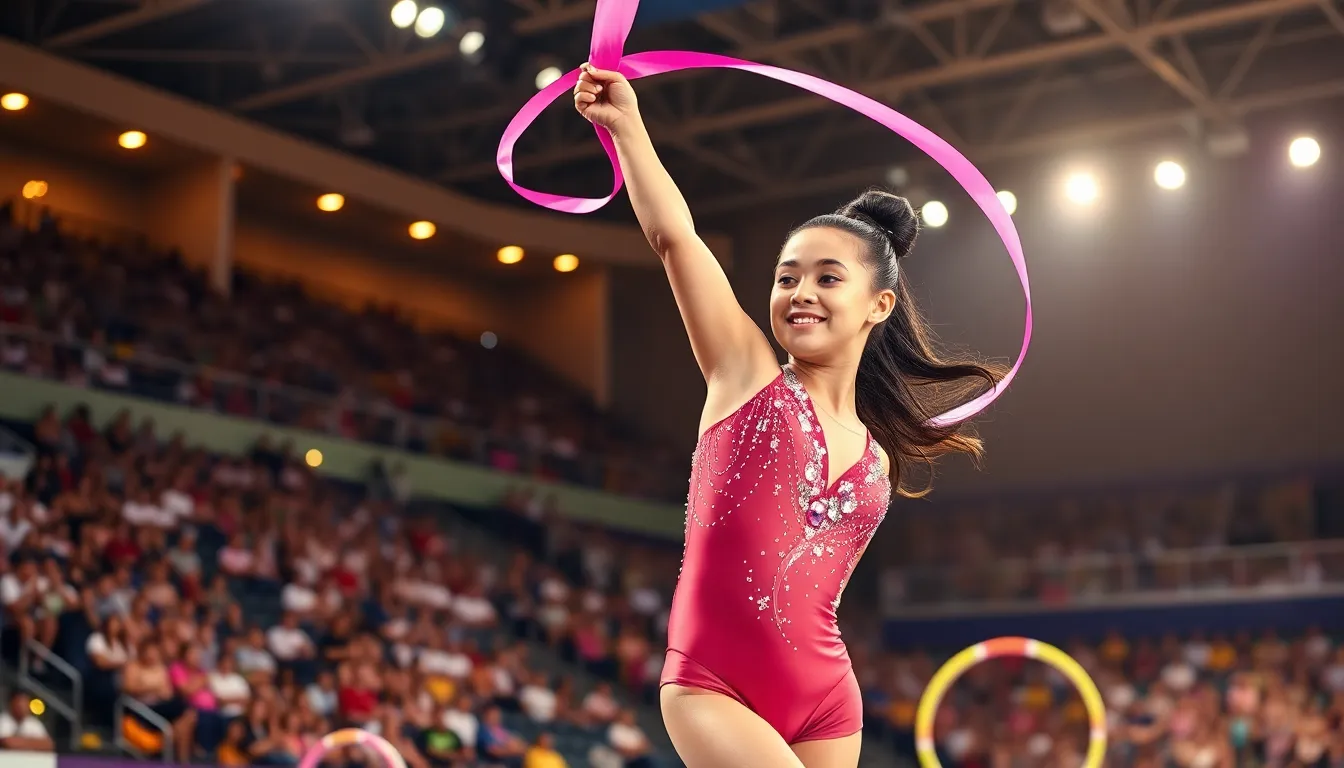Table of Contents
ToggleRhythmic gymnastics offers a mesmerizing blend of dance, flexibility, and artistry, captivating audiences around the globe. As one of the most elegant sports that combines athleticism with grace, it has seen dramatic evolutions in techniques, competition structures, and athlete performances over the years. This article explores the latest buzz surrounding rhythmic gymnastics, from recent competitions to emerging trends and future prospects in the sport.
Overview of Rhythmic Gymnastics

Rhythmic gymnastics is a unique sport that blends elements of ballet, dance, and gymnastics, performed with various apparatus like ribbons, hoops, balls, clubs, and ropes. Originating in the late 19th and early 20th centuries, it has evolved from a purely artistic expression to a highly competitive discipline recognized by the International Gymnastics Federation (FIG). Competitors execute choreographed routines that highlight their technical prowess, flexibility, and creativity, all set to music, making rhythm a crucial aspect of the performances.
This sport has two main categories: individual and group rhythmic gymnastics, showcasing solo performances and team collaborations respectively. While individuals may focus on mastering each apparatus, groups often emphasize synchronization and dynamic formations, adding layers of complexity to their routines. Rhythmic gymnastics was introduced as an Olympic sport in 1984, further elevating its global profile and competitiveness.
Recent Competitions and Highlights
The world of rhythmic gymnastics has been bustling with various competitions recently, showcasing outstanding performances from top athletes. One such event is the 2023 World Championships held in Sofia, Bulgaria, where gymnasts from around the world competed fiercely.
Highlights included the stunning performance of Linoy Ashram from Israel, who clinched multiple medals and further solidified her status as a leading figure in the sport. Also, the Russian team continued to dominate even though the controversies surrounding their participation, displaying impeccable synchronization and technical skills that set new benchmarks.
Besides, the Grand Prix series has been another significant platform for rhythmic gymnasts to shine. These competitions allowed newcomers to make a name for themselves, with emerging talents showcasing innovative routines that blend traditional techniques with modern interpretations. These events have been pivotal in generating excitement and engagement among fans and aspiring gymnasts alike.
Key Athletes to Watch
As rhythmic gymnastics evolves, several athletes are standing out for their exceptional skills and creativity.
- Linoy Ashram (Israel): As a current Olympic champion, Ashram continues to impress with her technical precision and artistic expression. Her innovative use of props has captivated judges and audiences alike.
- Dina Averina (Russia): A well-decorated gymnast, Averina has had a remarkable career marked by multiple world championships. Her fierce competitive spirit and disciplined training make her a perennial favorite in every competition.
- Bela Karpova (Hungary): A promising talent, Karpova has shown extraordinary versatility in her routines. Known for her engaging stage presence, she is quickly gaining popularity and is expected to be a future star.
- Lia Dzhumakhova (USA): Emerging from the United States, she is gaining attention for her unique choreography and expressive performances that break the mold of traditional routines.
Watching these athletes not only provides insight into the potential of the sport but also inspires future generations.
Trends in Rhythmic Gymnastics
Recent years have seen several notable trends in rhythmic gymnastics that reflect a shift in style, training, and audience engagement.
- Artistic Integration: Modern routines are increasingly incorporating elements from other dance styles, including hip-hop and contemporary dance, making performances more relatable and engaging for viewers.
- Increased Use of Technology: Coaches are using advanced technology, such as video analysis and motion tracking, to refine their athletes’ movements and improve performance accuracy.
- Sustainability and Inclusivity: Many gyms and teams are adopting sustainable practices in their training regimens and competitions, emphasizing inclusivity and opportunities for athletes from all backgrounds. This contributes to a broader acceptance and support for rhythmic gymnastics as a global sport.
Training Techniques and Innovations
Training in rhythmic gymnastics has seen a significant evolution, driven by advancements in sports science and coaching methodologies. The incorporation of cross-training, such as ballet, dance, and strength training, is becoming popular to enhance flexibility, strength, and coordination.
Also, training facilities are increasingly investing in specialized equipment, including resistance bands and Pilates reformers, to help gymnasts develop better core strength. Coaches are focusing on mental training techniques, emphasizing visualization and psychological resilience, which are crucial for optimal performance under pressure. New approaches also include injury prevention techniques, ensuring athletes maintain peak physical condition throughout their careers.
Future of Rhythmic Gymnastics
The future of rhythmic gymnastics appears bright, with growing popularity among youth and increased global interest in the sport. The upcoming Olympics and World Championships are set to showcase fresh talents, injecting new energy into the competitions.
Efforts to enhance visibility and fan engagement, especially through social media platforms and live streaming, are anticipated to boost viewership and interest in rhythmic gymnastics globally. Also, as more countries embrace this sport, it will foster a more competitive environment, encouraging athletes to push their boundaries and innovate further.
Educational programs to promote rhythmic gymnastics at the grassroots level are also critical for nurturing young talents and ensuring the sport’s sustainability. The combination of these factors suggests a promising trajectory for rhythmic gymnastics.
Conclusion
Rhythmic gymnastics remains a captivating sport, blending artistry with athleticism in ways that continue to enthrall audiences worldwide. Recent developments, highlighted by the outstanding performances in competitions and the emergence of talented athletes, indicate a dynamic landscape for the sport. As training techniques evolve and trends shift, rhythmic gymnastics is set to grow, drawing in more fans and inspiring future generations of gymnasts. The commitment to innovation, inclusivity, and sustainability will undoubtedly play a significant role in shaping its future, ensuring that rhythmic gymnastics continues to flourish.







